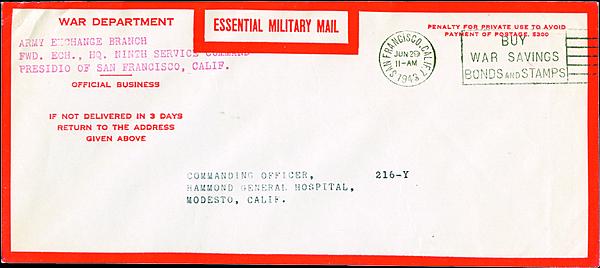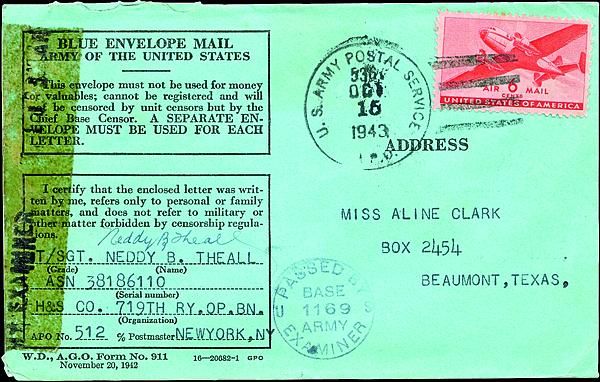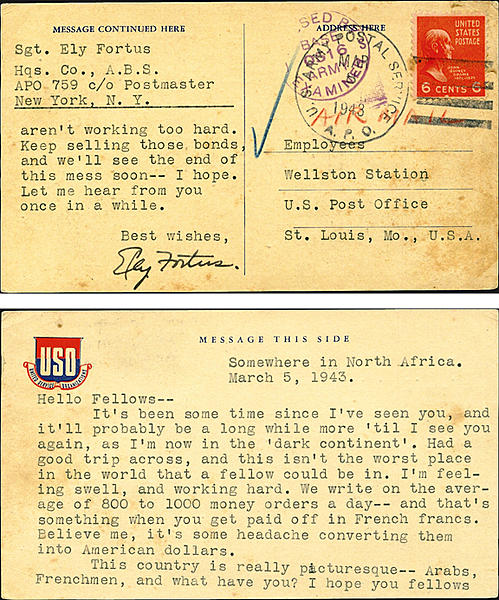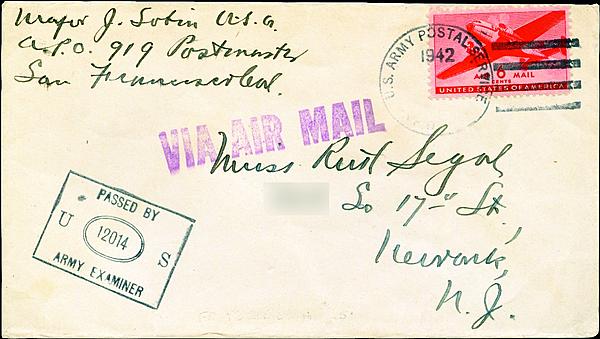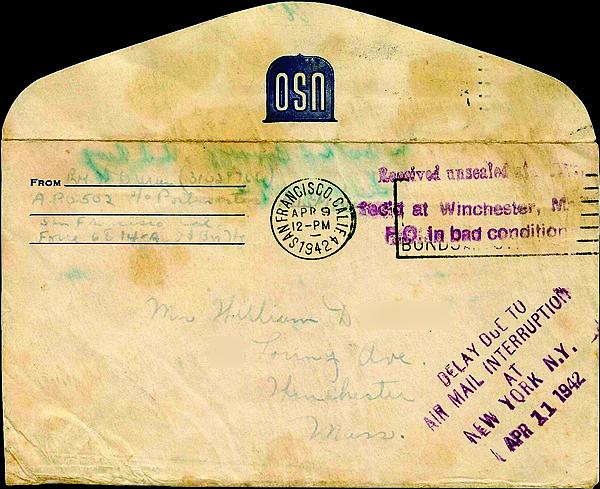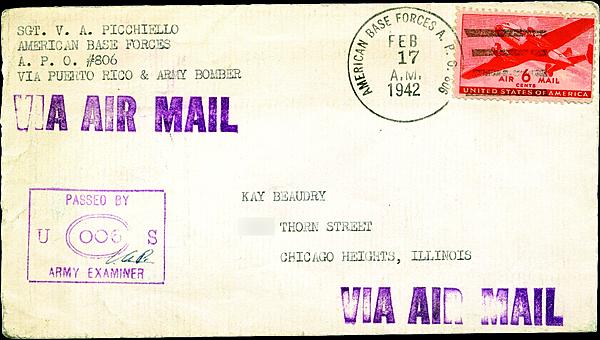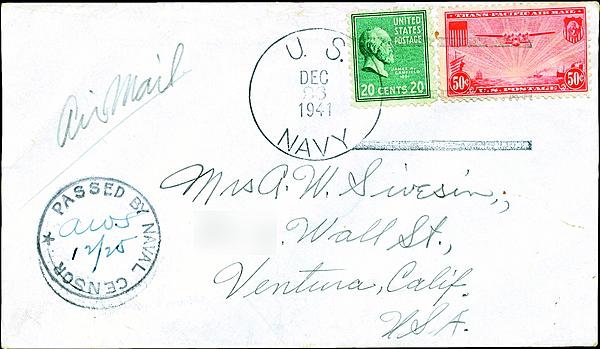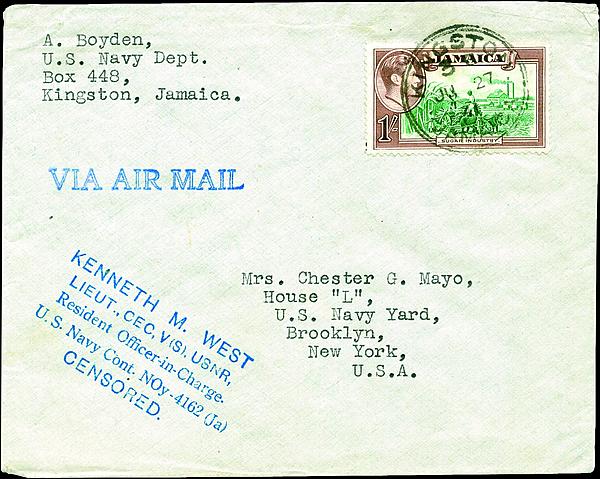US Stamps
American armed forces airmail during World War II: Part 1, 1941-43
Neither the United States armed forces nor the U.S. Post Office Department were prepared to meet the needs of wartime mail service when Japanese bombers brought death and destruction to Pearl Harbor on Dec. 7, 1941. It was immediately evident, however, that rapid, reliable postal communication was not just a military necessity, but an essential element of national morale.
That posed unanticipated challenges for both POD and military representatives, but elements of the solutions were already in place. Earlier in 1941, the United States had established foreign bases at seven locations in the Atlantic Ocean and the Caribbean Sea, leased from Great Britain in exchange for 50 destroyers.
At first, American military personnel stationed at those bases had to use foreign postal facilities for their mail. The Figure 1 airmail cover, sent by a Navy man from his post at Kingston, Jamaica, to Brooklyn June 27, 1941, is an exceptionally nice example, showing a blue U.S. military censor mark that was in use only briefly.
In short order, Army Post Offices were established at all seven foreign bases as branches of the New York City post office. The last of the original group to open was APO 804 at Fort Simonds, Jamaica, Nov. 17, 1941, just three weeks before Pearl Harbor. Surface mail to and from APOs in foreign countries required only domestic rates of postage, but airmail postage on letters to and from those locations equaled the international rates then in effect for mail from the United States.
The highest rate for an overseas Army address before the Pearl Harbor attack was 30¢ per half ounce to and from APO 807, established July 9, 1941, at Atkinson Field, British Guiana. Not surprisingly, soldiers and their correspondents complained about the expense and noted that their mail was flown to Trinidad aboard Army bombers at no cost to the POD, so at worst they should have been charged the 15¢ Trinidad rate.
Despite those logical arguments, Third Assistant Postmaster General Ramsey S. Black denied their request for reduced postage on Sept. 3. Foreign airmail rates remained in effect for mail to and from Army and Navy post offices abroad.
The policy Black upheld was congruent with the schedule for civilian airmail rates between the U.S. mainland and overseas possessions, the highest of which was 50¢ per half ounce for the Philippines. The 50¢ rate applied equally to civilian mail and to military letters mailed from the Navy post office at Manila.
Airmail to and from U.S. Navy ships in Asian waters and the Marine Embassy Detachment in China required 70¢ per half ounce.
Christmas 1941 Airmailvia Australia to California
The problem of high airmail rates for modestly paid servicemen deployed to foreign shores and at sea, and for loved ones writing to them from home, worsened after the United States entered the war in December 1941. The highest airmail rate to the most distant foreign destinations was then 70¢ per half ounce, as seen on the Figure 2 cover from the Navy cargo ship USS Gold Star to Ventura, Calif.
As the Gold Star steamed toward Australia, Chief Machinist’s Mate Arthur W. Sivesin endorsed the letter to his wife “Air Mail,” and dated and initialed it Dec. 25 inside the circular censor’s mark, which was Dec. 24 at locations east of the International Date Line, including the United States.
The ship’s mail clerk canceled it Dec. 26 — Christmas Day in California.
In one respect, those men were lucky to be stationed so far away. The Gold Star had been Guam’s guard ship and lifeline to the outside world. The ship had sailed to the Philippines to pick up supplies in early December, and thus was away from its base when Japanese invaders captured and occupied Guam Dec. 10. The commander of the Asiatic Fleet ordered the ship next to proceed to Balikpapan, Borneo.
Gold Star reached its Netherlands Indies destination Dec. 14. After hastily delivering supplies to Australian forces fighting to halt the Japanese advance in New Guinea, the ship was ordered to Darwin, Australia, where it arrived Dec. 28. The U.S. Army Air Corps Ferrying Command had established a base at Darwin, so Sivesin’s optimistically franked Christmas letter might have been transported by air to Hawaii and San Francisco even though regular airmail service had not yet been established.
If so, it was undoubtedly flown to Hawaii as a favor, perhaps in a pilot’s pouch, a frequently reported courtesy for fellow servicemen during America’s early involvement in the war.
The first American Base Forces post office in Australia, as Army Post Offices originally were designated, was APO 501, established Jan. 1, 1942, at Melbourne, on the far side of the continent from Darwin.
Wrestling with Airmail Service Problems
Airmail service in the opposite direction would have been much less likely in December 1941. According to the official report Army Postal Service During World War II, “Tremendous demands for rapid transportation of essential equipment and supplies during the early days of the war consumed practically all available space aboard aircraft and as a result very little mail was transported overseas by air.”
After gradually increasing the volume of outgoing airmail and then by inaugurating microfilmed V-mail service June 15, 1942, to reduce the burdens of space and weight, the problem of trans-Pacific congestion worsened as the number of fighting men shipped overseas grew.
Determined efforts by the military authorities eventually solved those problems:
War Department Circular 292, dated 29 August 1942, directed the discontinuance of air service for personal and nonessential official air mail to [Hawaii]. As more planes became available this restriction was lifted by War Department Circular 360, dated 30 October 1942 …
A large number of tactical aircraft being ferried to overseas points aided materially in the transportation of mail. However, as their departure could not be projected in advance it was impossible to set aside specific mail allotments. In order to secure all possible air space available, postal liaison officers from ports of embarkation were detailed to air fields from which tactical aircraft departed. Through their personal contacts with pilots and officials of air fields, these officers were able to secure space aboard tactical aircraft for a considerable amount of mail.
Commercial airlines were used for the transportation of air mail to certain areas when more efficient service could be rendered by such airlines. Only mail, however, prepaid at the air mail rate of postage was dispatched by commercial aircraft. By close liaison with the Navy Department, considerable space was secured aboard naval aircraft for the transportation of Army mail. To reciprocate for the transportation furnished by the Navy Department, the Army Postal Service from time to time arranged for transportation of Navy mail through Army Postal Service channels to areas where their service was infrequent.
A notice in the February 3, 1943, Postal Bulletin answered a frequently asked question:
Many postal patrons have wondered why there is more rapid and regular mail service from the armed forces than to them. This is because less mail comes from overseas than goes to our armed forces overseas; and the location of addresses in this country is more stable than that of overseas personnel.
By 1943 only a few service bottlenecks continued to pose significant delays.
A Compromise Armed ForcesAirmail Letter Rate
The Sept. 3, 1941, order that reaffirmed foreign airmail rates for overseas military personnel had failed to put the issue to rest.
As the POD’s postwar report A Wartime History of the Post Office Department explained, summarizing negotiations between Second Assistant Postmaster General Smith W. Purdum and representatives of the War Department,
… surface transportation of mails to the increasingly far-flung American bases was uncertain and slow, whereas air mail transportation was expeditious and highly desirable from a morale point of view. It was also indicated that the farther away from home a soldier might be located, and therefore more in need of news from home, the more air mail postage he would have to pay. At locations in the Pacific area the postage might cost as much as 70 cents per half ounce, which fee an enlisted man could ill afford. Out of the extended representations and consideration came a proposal to establish a flat postage rate of 6 cents per ounce, to be applicable to airmail letters intended for or emanating from soldiers outside the continental United States. As a result, a regulation permitting a compromise rate of 6 cents per half ounce was promulgated on December 23, 1941, and this privilege was extended to civilians on October 22, 1942. This beneficial reduction in air mail cost definitely helped morale overseas, awakened the general public to the possibilities of air mail service, and proved to be the principal source of postal revenues from servicemen throughout the war years.
Thus was born the concessionary airmail letter rate, reflected on most of the covers illustrated with this article. Although “promulgated” on Dec. 23, it was actually first announced “at the request of the President” in a POD news release embargoed for publication until the morning of Christmas Day, Dec. 25, too late to have affected the Figure 2 cover.
Official notice of the rate appeared in the Dec. 26 Postal Bulletin. Considering the Army’s difficulty transporting airmail overseas at that time, it was partly a symbolic gesture, whose promise of outward bound service was largely fictitious until mid- to late 1942. But most homeward bound airmail letters from soldiers and sailors did receive the service they paid for.
Numbered Location Codes,the Mail Distribution System
For security reasons, the War, Navy, and Post Office Departments forbade the use of geographic locations in military addresses, and censors deleted any references to them in letters or enclosures except for vague phrases such as “somewhere in the South Pacific.” The Army Postal Service report explained:
When mail is deposited in a civilian post office in the United States it is sent to a postal concentration center. This is a civilian post office agreed upon by the War and Post Office Departments as the place for which mail for a particular theater or area will be concentrated. This post office is usually located in or adjacent to a port of embarkation. The concentration center sorts the mail according to Army post offices and organizations, sacks it and turns it over to the embarkation Army post office for dispatch to overseas theaters … Mail arriving in overseas theaters is unloaded at the port of debarkation and normally dispatched to a base post office. From the base post office it may be dispatched in bulk, either direct to APOs or to Postal Regulating Sections. If to a Postal Regulating Section, the mail is then routed by the most expeditious transportation available to the various APOs. From the APOs the mail is routed to regimental distribution points or delivery may be made direct to regimental and separate organization mail clerks.
Incoming Army mail followed the same path in reverse, and entered the domestic mailstream at the designated postal concentration centers, which were located at Miami, Fla.; Minneapolis, Minn.; New Orleans, La.; New York, N.Y.; Presque Isle, Maine; San Francisco, Calif.; and Seattle, Wash. The Navy used a similar system of numbered locations routed through postal concentration centers at New York and San Francisco.
Locating Code-Numbered Military Post Offices Overseas
The Figure 3 airmail cover was mailed at APO 806 Feb. 17, 1942. To learn the location of that post office on that date one must consult a locator list. The current and most complete edition is a three-volume set published by the Military Postal History Society.
Numbered Army & Air Force Post Office Locations, Vol. 1, shows that APO 806, located at Antigua, British West Indies, until 1944, was one of the original seven that had opened overseas before the attack on Pearl Harbor.
The endorsement “VIA PUERTO RICO AND ARMY BOMBER” specified a transport service that predated scheduled military airmail routes.
Effective dates for APO addresses published in the locator list might not always be authoritative.
Consider the Figure 4 cover, sent by Pvt. William P. Duran, a member of Task Force 6814, to his wife in Massachusetts.
His return address was APO 502, established at Noumea, New Caledonia, March 12, 1942, according to the book, yet the envelope was canceled at San Francisco on April 9, not at the military post office in the South Pacific.
A snippet of historical context might help explain the discrepancy.
Task Force 6814 had been hastily assembled at New York and departed Brooklyn Jan. 23 in a convoy of eight transport ships, several of which were converted luxury liners, escorted as far as the Panama Canal by destroyers and aircraft.
The convoy moved into the Pacific at the beginning of February and arrived at Noumea Harbor March 12. Contemporaneous descriptions of the confusion and pandemonium that attended the U.S. Army’s first major deployment to the South Pacific make it unlikely that a functioning post office actually began service on that date, or during the next couple of weeks.
On April 3, Task Force 6814 became the Americal Division, so it’s reasonable to think that Pvt. Duran had written his letter earlier. I surmise that he handed it to a crew member on one of the returning ships, who posted it for him at San Francisco. United Air Lines trip 18 transported the letter from Oakland to New York City, where the plane crashed into Flushing Bay while attempting to land at La Guardia Airport on April 11.
The magenta “DELAY DUE TO AIR MAIL INTERRUPTION NEW YORK N.Y. APR 11 1942” ancillary marking was one of three similar cachets applied to 1,056 pounds of water-soaked mail salvaged from the crash site.
Two additional markings — “Received unsealed at N.Y.” and “Rec’d at Winchester, Mass. P.O. in bad condition” suggest that postal officials in both places took care to assure that the POD would not be blamed for this letter’s mishap.
The Figure 5 airmail cover was mailed some time in 1942 from APO 919, located at Bora Bora in the Society Islands, to Newark, N.J. The 1942 cancel with only the year date is an oddity peculiar to that APO.
The archipelago saw no combat, but nevertheless holds a special place in popular lore as a distant tropical paradise where lovelorn white Americans, far from home, learned the lesson of racial tolerance.
Everyone who has enjoyed stage and motion picture versions of the Rodgers and Hammerstein musical production South Pacific knows the story. Bora Bora in French Polynesia is one of four Pacific islands that claim to have been James A. Michener’s fictional Bali Ha’i in his Tales of the South Pacific. It wasn’t. He had never been stationed there during his Navy service.
But according to a 2004 article in the Chicago Tribune, when he finally saw Bora Bora, Michener called it “Bali Ha’i of the spirit” and said that “there can be no other [Polynesian island] more perfect than this … I created an idea long before I saw its reality, and I believe that often happens in art.”
Airmail fromNorth Africa
In November 1942, American and British forces mounted Operation Torch, a series of amphibious landings in Morocco, Algeria, and Tunisia with the aim of evicting Axis armies from North Africa and regaining control of the Mediterranean Sea for eventual assaults on the European continent.
APO 759 was established Feb. 22, 1943, at Casablanca, Morocco. Sgt. Ely Fortus sent the Figure 6 postcard from there with the heading “Somewhere in North Africa, March 5.”
Sgt. Fortus had been a postal clerk at Saint Louis before going into the service, and the Army had assigned him to postal duty on the “dark continent,” as he called it, sharing his APO experience with his fellow postal workers at home:
“We write on the average of 800 to 1000 money orders a day,” he wrote, “and that’s something when you get paid off in French francs. Believe me, it’s some headache converting them into American dollars.”
Sending news to and receiving news from home were not the only reasons a soldier needed personal mail. Letters also provided opportunities to air personal problems and to share intimacy, subjects that might be embarrassing or humiliating if they were read by a serviceman’s superior officer who served as his unit’s censor. To avoid that problem, the Army created Blue Envelope Mail, illustrated in Figure 7.
Blue envelopes were censored by a chief base censor, not by the sender’s unit censor. Money and valuables could not be enclosed, and the letters could not be registered. Senders certified that the letters referred only to personal or family matters. This example was mailed at APO 512, located at Algiers, and canceled at APO 536, located at Constantine, Algeria, about 200 miles away.
Essential Military Mail
For the entire duration of the war, postage-free essential Official mail had first claim on both domestic and international air transport ahead of all other categories. Figure 8 pictures a June 29, 1943, Essential Military Mail cover from San Francisco to Modesto, Calif. Unlike personal correspondence, no weight limits applied to Official mail.
Thus far we have surveyed a variety of military airmail from the first two years of United States involvement in WWII.
My next Spotlight column will follow this subject into 1944, as our country’s armed forces invaded the European continent, advanced westward across the Pacific Ocean and liberated Guam.
MORE RELATED ARTICLES
Headlines
-
US Stamps
Oct 7, 2024, 3 PMMcMurtrie dismissed as APS education director following Sept. 21 arrest
-
US Stamps
Oct 7, 2024, 12 PMVasiliauskas named president of Mystic Stamp Co.
-
US Stamps
Oct 6, 2024, 5 PMApgar souvenir card available
-
US Stamps
Oct 6, 2024, 4 PMFirst Continental Congress and U.N. stamps receive Scott catalog numbers
